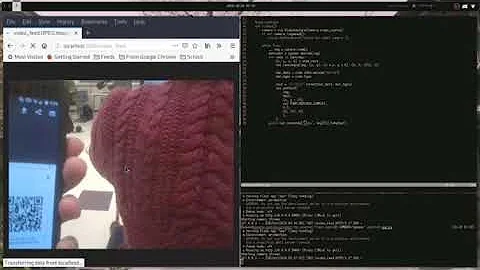Flask video stream using OpenCV images
for accessing camera other than your laptop's webcam, you can use RTSP link like this rtsp://admin:[email protected]:554/h264/ch1/main/av_stream"
where
> username:admin > password:12345 > your camera ip address and port > ch1 is first camera on that DVR
replace cv2.VideoCamera(0) with this link like this for your camera and it will work
camera.py
import cv2
class VideoCamera(object):
def __init__(self):
# Using OpenCV to capture from device 0. If you have trouble capturing
# from a webcam, comment the line below out and use a video file
# instead.
self.video = cv2.VideoCapture(0)
# If you decide to use video.mp4, you must have this file in the folder
# as the main.py.
# self.video = cv2.VideoCapture('video.mp4')
def __del__(self):
self.video.release()
def get_frame(self):
success, image = self.video.read()
# We are using Motion JPEG, but OpenCV defaults to capture raw images,
# so we must encode it into JPEG in order to correctly display the
# video stream.
ret, jpeg = cv2.imencode('.jpg', image)
return jpeg.tobytes()
main.py
from flask import Flask, render_template, Response
from camera import VideoCamera
app = Flask(__name__)
@app.route('/')
def index():
return render_template('index.html')
def gen(camera):
while True:
frame = camera.get_frame()
yield (b'--frame\r\n'
b'Content-Type: image/jpeg\r\n\r\n' + frame + b'\r\n\r\n')
@app.route('/video_feed')
def video_feed():
return Response(gen(VideoCamera()),
mimetype='multipart/x-mixed-replace; boundary=frame')
if __name__ == '__main__':
app.run(host='0.0.0.0', debug=True)
then you can follow this blog to increase your FPS
https://www.pyimagesearch.com/2015/12/21/increasing-webcam-fps-with-python-and-opencv/
Related videos on Youtube
Admin
Updated on June 23, 2022Comments
-
 Admin almost 2 years
Admin almost 2 yearsI am trying to use Flask to show a stream of OpenCV images. I am using ROS and the Zed stereo camera.
The issue is that the flask server only shows a broken image icon. I am guessing that the issue is in the gen() method because the cv2.imwrite('t.jpg', img) method is the wrong way to go. I have very little experience with OpenCV.
The image data that the Flask server receives is an InputArray. I need a way of converting this and showing the image in the Flask server.
I am using Python 2.7 and rospy (ROS).
Any advice?
UPDATE:
The code for the ROS node accessing ZED cam:
#!/usr/bin/env python # ROS imports import rospy from sensor_msgs.msg import Image # Utils import numpy as np import cv2 from cv_bridge import CvBridge, CvBridgeError import stream def callback(data): """ param data: data from zed/rgb/image_rect_color topic """ # convert from ROS sensor_msgs/Image to cv2 bridge = CvBridge() try: cv_img = bridge.imgmsg_to_cv2(data, desired_encoding='passthrough') stream.img = cv_img except CvBridgeError as e: print(e) # show image stream # cv2.imshow('zed', cv_img) # cv2.waitKey(3) def zed_sub(): # initialize ROS node 'zed_sub' rospy.init_node('zed_sub') # subscribe to the ROS topic 'zed/rgb/image_rect_color' rospy.Subscriber('zed/rgb/image_rect_color', Image, callback) # keep python from exiting until this node is stopped try: rospy.spin() except KeyboardInterrupt: cv2.destroyAllWindows() if __name__ == '__main__': zed_sub()The code for the Flask server:
#!/usr/bin/env python from flask import Flask, render_template, Response import cv2 app = Flask(__name__) HOST = '192.168.1.3' # on-board computer's IP address PORT = 8080 img = None @app.route('/') def index(): return render_template('index.html') @app.route('/video_feed') def video_feed(): return Response(gen(), mimetype='multipart/x-mixed-replace; boundary=frame') def gen(): """Video streaming generator function.""" global img while True: try: cv2.imwrite('t.jpg', img) yield(b'--frame\r\n' b'Content-Type: image/jpeg\r\n\r\n' + open('t.jpg', 'rb').read() + b'\r\n') except NameError as e: print(e) if __name__ == '__main__': app.run(host=HOST, port=PORT, debug=True, threaded=True)-
K P about 6 yearswhy are you doing cv2.imwrite('t.jpg', img) ?
-






